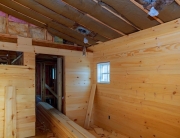Preparing a lot for a log siding home is essentially the same as for a conventional home. One difference is the location of the lot – typically in the suburbs or country. All thing considered, its location can change some of the variables for preparing the property for building. Altogether, The pre-building work creates a safe and viable construction site.
Once you select a few pieces of land to evaluate and create the home plans, the site work begins. You must make a list of the local entities whose services go into the site preparation. These professionals open the way for the contractor and subcontractors to do their work:
- Firstly, Lot site evaluation and soil testing
- Make a log siding home lot plan
- Survey the site
- Clear and grade the lot
- Compact the soil
- Let the contractor begin
Consequently, each of these steps is necessary to prepare your log siding home lot for a safe and viable place to reside.
Lot Site Evaluation and Soil Testing
You, as the homeowner, must evaluate the building sites to make sure they are what you want. Not all pieces of land are suitable for your project. Correspondingly, you must ask and answer these questions.
- Is it in the best location for you?
- Was the lot the right size and shape?
- Is the slope of the land suitable?
- Do your plans meet local zoning regulations?
- Does your selection fit into the budget?
- Will hooking up utilities cost extra for the site?
You want to be sure the property meets all the required criteria. You can consult with a few contractors to get their opinions to help answer the questions. Next, you must have the soil tested for the properties and composition of the rock, soil, and groundwater under the lot. These tests will reveal the strength and soil-bearing capacity as well as how it absorbs water. If your first choice of lots does not test well, you must go to your second choice.
Make a Log Siding Home Lot Plan
 Once you have picked out the lot, it is time to make a log siding home lot plan. At the same time, it should contain these components and be reviewed by the city or county building inspector:
Once you have picked out the lot, it is time to make a log siding home lot plan. At the same time, it should contain these components and be reviewed by the city or county building inspector:
- Placement of any septic tanks
- A drainage system, if needed
- The access road for construction vehicles
- Any demolition or earthwork needed
- Temporary construction storage areas
- Placement of a driveway
All city and county building permits must be obtained to endure compliance with local codes.
“Once you have selected the land and created the home plans, the site work begins. You must make a list of the local entities whose services go into the site preparation.”
Survey the Site
You must use a professional surveyor to correctly identify the corners of your lot. Unless this is done accurately, you may be building on part of your neighbor’s property. The survey will show where utilities, fixtures, and structures will be located on the lot. Likewise, building in a heavily developed area may require an underground utility map to pinpoint buried cables, pipes, or lines. The map will help prevent damage to any existing utilities.
Clear and Grade the Log Siding Home Lot
 Now the actual work begins and you can see the lot taking shape. First, clear the land by:
Now the actual work begins and you can see the lot taking shape. First, clear the land by:
- Demolishing and removing old buildings or junk
- Cutting down trees and bushes and removing them
- Eliminating any underground issues
Next, shape the land to meet your specifications by:
- Grading the lot to the right slope with heavy equipment
- Filling and leveling the site
Now you are ready to move on by compacting the soil.
Compact the Soil for a Solid Foundation
After the lot is filled in, the soil must be compacted to bear the weight of your log home’s footers and foundation. This is accomplished by mechanically increasing the density of the soil. When done properly, the dirt will be settled down enough to prevent shifting and further settlement. This way, you can avoid unnecessary maintenance costs or structure failure. Learn more about soil compaction from Mintek Resources.
Begin the Home Construction
Now the lot work is finished, it must be inspected so it will meet building codes and zoning requirements. Once you get the OK, the contractor will line up the subcontractor to begin the work. The process of preparing a log siding home lot can take a few weeks to a few months depending on the weather, inspections, and availability of the contractor.
You can purchase the log siding, corners, and trims from The WoodWorkers Shoppe. Our high-quality materials are fairly priced so you can keep within your building budget.







Recent Comments